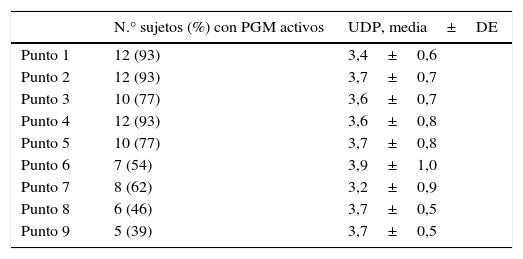El dolor lumbar de causa mecánica es una patología prevalente, siendo una de las causas asociadas el dolor en la zona glútea. El síndrome de dolor miofascial es uno de los cuadros dolorosos crónicos más frecuente del sistema músculo-esquelético y se encuentra representado por los puntos gatillo miofasciales (PGM). El objetivo de nuestro estudio fue determinar qué zona del músculo glúteo medio se encuentra más afectada por la presencia de PGM activos en pacientes con dolor lumbar inespecífico de origen mecánico.
MétodoSe realizó una serie de casos en la que se exploró a 13 pacientes con dolor lumbar de origen mecánico. Se evaluó la presencia de PGM activos y los umbrales de dolor a la presión (UDP) sobre el músculo glúteo medio. Se elaboró un mapa topográfico del músculo glúteo medio mediante 9 puntos para determinar la zona anatómica más afectada.
ResultadosLa intensidad media del dolor fue de 6,4±1,7cm y el tiempo medio de duración del dolor fue de 6,2±4,1 años. Cada paciente con dolor lumbar mostró una media±DE de PGM activos sobre el músculo glúteo medio de 5,6±1,3. No se encontró asociación alguna entre el número de PGM activos sobre el glúteo medio y el tiempo de duración de los síntomas (r=0,191; p=0,622) o la intensidad del dolor (r=0,026; p=0,932). Los PGM activos sobre el glúteo medio se encontraron más frecuentemente en las fibras más posteriores y superiores del músculo (puntos 1-2-4), aunque las fibras antero-superiores (punto 3) y medias (punto 5) también albergaron gran cantidad de PGM activos. No existieron diferencias significativas en los UDP entre los distintos puntos.
ConclusionesEl presente estudio encontró que las fibras posteriores y superiores del músculo glúteo medio se encuentran más afectadas por PGM activos en pacientes con dolor lumbar de origen mecánico.
Mechanical low back pain is one of the most prevalent pain conditions and is associated with pain in the gluteal region. Myofascial pain syndrome is a common condition associated with musculoskeletal pain which is mainly represented by myofascial trigger points (MTrPs). The aim of this study was to determine which area of the gluteus medius muscle is the most affected by active MTrPs in patients with low back pain.
MethodsA case series that included 13 patients with mechanical low back pain was performed. Active MTrPs and pressure pain thresholds (PPT) were assessed on the gluteus medius muscle. A topographical map of the gluteus medius muscle was elaborated using 9 points around the muscle to determine the most affected anatomical zone.
ResultsThe intensity of low back pain was 6.4±1.7cm and mean time with pain was 6.2±4.1 years. Each low back pain patient exhibited a mean±SD number of active MTrPs of 5.6±1.3 on the gluteus medius. No association was found between the number of active MTrPs on the gluteus medius and the duration of pain history (r=0-191; P=0.622) or the intensity of pain (r=0.026; P=0.932). Active MTrPs within the gluteus medius muscle were most frequently found in the posterior and superior fibers of the muscle (points 1-2-4). Active TrPs were also found in the anterior and superior (point 3) and medium fibers (point 5) of the muscle. No significant differences were found on PPT between points.
ConclusionsIn the current study, it was found that the posterior and superior fibers of the gluteus medius muscle were the most affected by active MTrPs in patients with mechanical low back pain.
Artículo
Si ya tiene sus datos de acceso, clique aquí.
Si olvidó su clave de acceso puede recuperarla clicando aquí y seleccionando la opción "He olvidado mi contraseña".









